Yup, it has that and some pretty wild-looking taillights too. And it’s pink! (not really, it’s desert rose but it sort of looks pink). There’s no special model designation in this case, it’s noted by Imperial literature as a Six-Passenger Sedan. And, it really doesn’t need a special moniker as it has a pretty commanding presence just as it sits. Claimed to have only experienced 47K miles, this 1956 Imperial is located in New Castle, Indiana, and is available, here on eBay for a current bid of $12,156 with the reserve not yet met.
Now in its second year as a separate brand under the Chrysler Corporation umbrella, the changes between the two years were modest (’55 had a shorter wheelbase). These are big cars measuring 229.6 ” in length, riding on a 133″ wheelbase, and tipping the scales at approx. 4,800 lbs. Total production was less than 11K copies with the Six-Passenger Sedan, such as our subject car, yielding about 6,800 units.
There’s no backstory regarding this car’s whereabouts over all of these years, or how it ended up with such low, undocumented mileage, but it has been stored well as it still presents beautifully. The seller suggests that the bumpers could stand to be replated but they show pretty well. The finish and trim are still strong and someone over the years has added bump strips down either side. I get the reason, and fortunately, they are unobtrusive, but they don’t do anything to enhance this car’s lines. We’re told that the undercarriage is clean with no rot but the included images aren’t too revealing. That said, there’s no reason to be concerned.
Power comes about as a result of a 280 gross HP, 354 CI “Hemi” V8 engine connected to a PowerFlite automatic transmission – the first year for the pushbutton actuated setup. The seller adds, “Car Purrs like a kitten very smooth running engine“.
I’m not sure about the interior. The velour upholstery looks great but I question its originality. The hue is certainly a great exterior match but examples that I could find displayed a light, repetitive, pattern to the cloth covering. The only foible mentioned is a slight tear but the one run-on sentence description in the listing makes scoping its location a chore – it’s not revealed in the images. Other than the radio’s current state, everything else works as originally planned. Of note is the working, color-keyed A/C unit (converted to 134 refrigerant) perched beneath the dash. All-in-all, the entire environment is in smashing condition!
This Imperial is a perfect poster child for the ’50s – it just oozes that decade. While the styling is not as trapezoidal as some of designer Virgil Exner’s later contributions, this one gets marks, especially for those gun-sight taillights. While I would like to know more about this Imperial’s past, it really doesn’t matter as what’s here and now is what really counts, right?
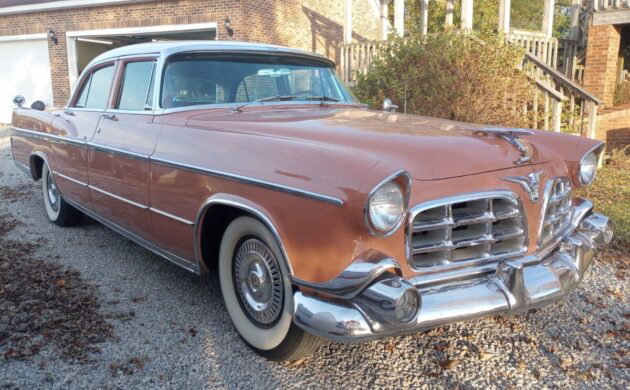
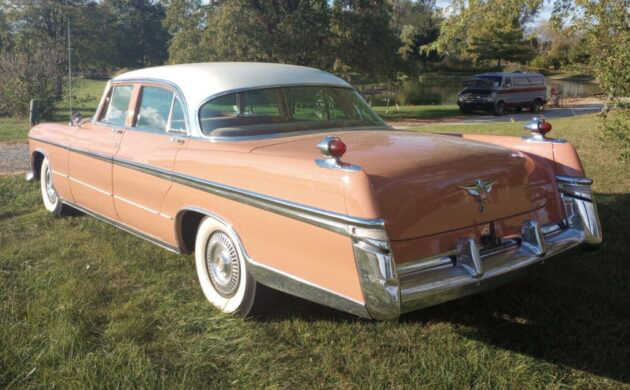
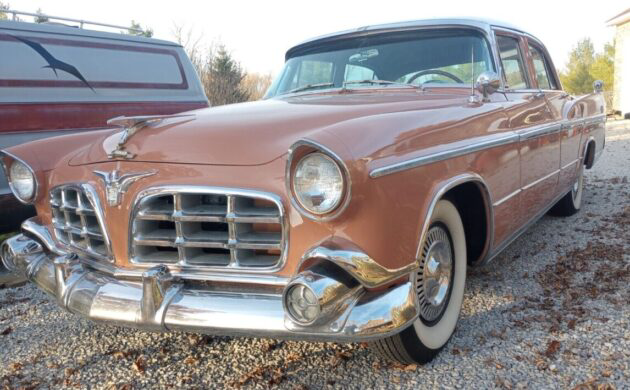
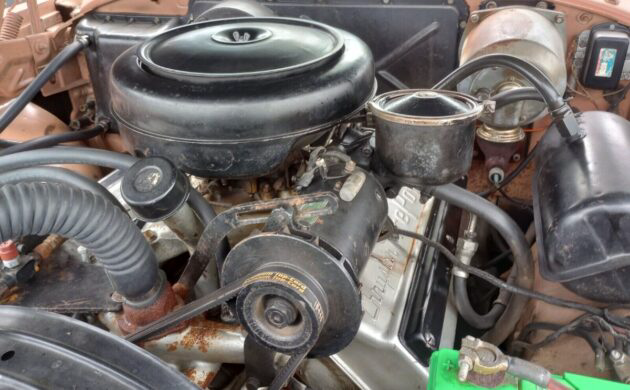
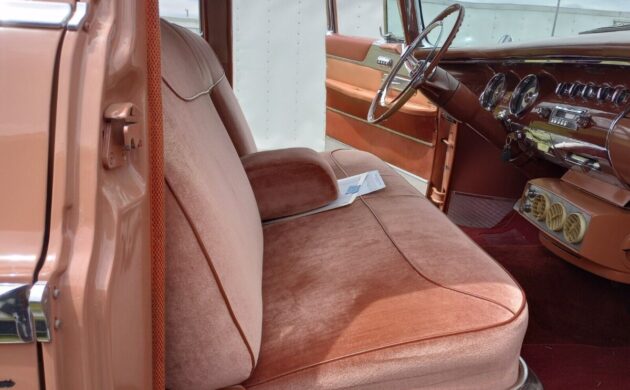


✔✔✔✔
Velour upholstery was an ’80s thing; just about every car made then had it. I’ve never seen a ’50s car with velour upholstery, this car has obviously had its interior re-done at some point. It looks good and matches the exterior color nicely, though. This is a nice car and, assuming the paint is original, I’d keep it as-is though I’d detail under the hood a bit. Maybe down the road reupholster the interior with original style upholstery to bring it back to original. Of course, a lot of that depends on what the seller wants for the car.
Never liked the taillights on these! Would’ve looked better if they were sculpted into the body!
Yup, I agree – they always looked like an afterthought ;like when they were designing the car , the rear designs looked great , and then some engineer said ” hey, where are the taillights supposed to go ?”
The ‘engineer’ being Virgil Exner.
With all that trim removed for a repaint you would think they wouldn’t paint the door latch! This is a stunning classic that I would have over the rest of the luxury lineup of the day.
They got paint on some of the weatherstripping too
My dad had one. They were faster and bigger than they look in the phot.
I guess I’ve spent my life pointing out the obvious. Didn’t gain much, but a little perspective is in order. A 1955 Ford pickup ( I don’t care if the plastic is on the seats) or this? I know, different markets require different methods of bilkiness(?) but how could one possibly compare value? For $15gs , you can have the absolute BEST car from the mid-50s that would suck that pickup( and a couple KIAs) through the air horn, a left lane car, fo sho.
Chrysler in the mid-50s was on a clear mission, be the hottest stick out there, and provide a cushy ride to boot. It did it all with this car, right here. Kiekhaefer was no idiot, he knew what to race, and cleaned up on everyone, I might add. The ’56 Dodge D-500 hemi was the fastest production car in the world in 1956, I read. Oh sure, plenty of competition, but nobody offered a hemi, clearly the most significant motor to come out of Detroit. People that bought these cars usually had highway travel in mind, and many secondary highways were still gravel. Mass was the key there, and at 4700 pounds, it had plenty, and needed the hemi. To be clear, the hemi was more or less just a gimmick, just like today. It was just a different way of doing the same thing. Wasn’t all that revolutionary, and I think was just one of the biggest displacement motors you could buy then. Most of the time, they were gutless, oily slugs, in mundane DeSotos, as they wore out, but one thing for sure, and didn’t take long for the others to catch up. Rambler took the fastest production car away from Dodge in 1957, but Imperials were top shelf, and we can see why. What a car!!
BTW, the tail lights were one of the last renditions of the WW2 “gun sight” doo-dads the others had a field day with.
My Uncle had one of these cars always liked the looks , he litterly ran his into the ground , 200k+ it was one sad puppy when he was done !
Listing says the A/C is “set up” for 134a, but what does that mean? I don’t see an A/C compressor in the photos.
Beautiful looking car. IMHO, it’s the best looking Imperial until the 1962 model year.
“Sparrow strainer” tail lights.
I’ve owned multiple 1955-56 Imperials, even drove a French assembled one as my everyday car in Central Europe in the 1970s. They are great road cars, especially one with the new Torqueflite 3 speed.
The upholstery should have a repeating pattern of eagles in the non-bolster areas.
I love those taillights. When seated in the driver’s seat, I can look in my rear view mirror and see in each “front” end of the chrome assembly, a faint glow at night, and stepping on the brake pedal, the light intensity increases, letting me know both taillight bulbs and brake light bulbs are working! As far as I know, until the late 1970s no other car let the driver know those lights were working!
The place to come for factoids I guess: I worked on a 1969 Continental MkIII a few years ago that had rear light indicators. FoMoCo had designed long clear-plastic cords that were aimed at the actual Stop/Tail bulb at each rear light, the other end terminated in a small jewel that was part of the rear glass’s upper headliner molding.
It showed up in the rear-view mirror so that the driver could easily check the lights’ function w/o a neck turn!
My dad had a 56 Imperial – Black with w/gray interior. Wonderful car. This one has been repainted at some point. Door latches are painted and some overspray on gaskets. Left rear bumper is dented. But I do like this one.
My aunt and uncle had one of those. Completely rusted out in 4 years. That makes this a true collector’s item in my book!
For me, the best looking part of the car is the front end of the car. I love the 1956 Imperial grille. Unless I’m mistaken, the grille looks the same as on the 1956 300.
Car nut,
The 2 main grill pieces the same. But the lower chrome above the bumper and the park lights are different.
Are they? I hadn’t noticed.